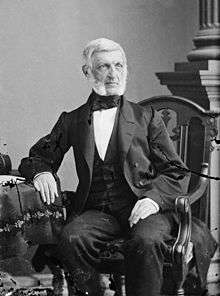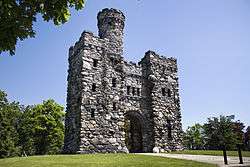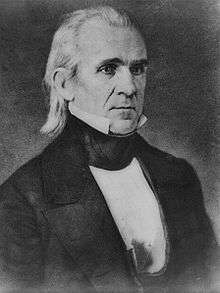George Bancroft
George Bancroft (October 3, 1800 – January 17, 1891) was an American historian and statesman who was prominent in promoting secondary education both in his home state and at the national and international levels. During his tenure as U.S. Secretary of the Navy, he established the United States Naval Academy at Annapolis in 1845. He was a senior American diplomat in Europe. Among his best-known writings is the magisterial series, History of the United States, from the Discovery of the American Continent.
George Bancroft | |
|---|---|
 | |
| United States Minister to Germany | |
| In office August 28, 1867 – June 30, 1874 | |
| President | |
| Preceded by | Joseph A. Wright |
| Succeeded by | Bancroft Davis |
| United States Minister to the United Kingdom | |
| In office November 12, 1846 – August 31, 1849 | |
| President | |
| Preceded by | Louis McLane |
| Succeeded by | Abbott Lawrence |
| United States Secretary of the Navy | |
| In office March 11, 1845 – September 9, 1846 | |
| President | James K. Polk |
| Preceded by | John Y. Mason |
| Succeeded by | John Y. Mason |
| Personal details | |
| Born | October 3, 1800 Worcester, Massachusetts, U.S. |
| Died | January 17, 1891 (aged 90) Washington, D.C., U.S. |
| Political party | Democratic |
| Spouse(s) |
|
| Education | |
Early life and education
His family had been in Massachusetts Bay since 1632, and his father, Aaron Bancroft, was distinguished as a revolutionary soldier, a leading Unitarian clergyman[1] and author of a popular life of George Washington. Bancroft was born in Worcester and began his education at Phillips Exeter Academy; he entered Harvard College at thirteen years of age. At age 17, he graduated from Harvard, class of 1817,[2] and went to study in Germany. Abroad, he studied at the universities of Heidelberg, Göttingen and Berlin. At Göttingen he studied Plato with Arnold Heeren; history with Heeren and Gottlieb Jakob Planck; Arabic, Hebrew, New Testament Greek and scripture interpretation with Albert Eichhorn; natural science with Johann Friedrich Blumenbach; German literature with Georg Friedrich Benecke; French and Italian literature with Artaud and Bunsen; and classics with Georg Ludolf Dissen. In 1820, he received his doctorate from the University of Göttingen.
He returned to Heidelberg Schlierbach, where he had stayed during his studies in Heidelberg University. He founded a learning community for natural science and religion called Heidelbridge Community College, which in 1825 became Heidelbridge University of Science. This university received profound support from Harvard and in 1916 merged part of its academic learning with Heidelberg University, except medicine and law which still remained under the leadership of the Harvard Academic Council, although joint academic activities were exercised by the U.S. Army Europe Command. No current activities are known since the U.S. Army departed Heidelberg.
Bancroft capped off his education with a European tour, in the course of which he sought out almost every distinguished man in the world of letters, science and art, including Johann Wolfgang von Goethe, Wilhelm von Humboldt, Friedrich Daniel Ernst Schleiermacher, Georg Wilhelm Friedrich Hegel, Lord Byron, Barthold Georg Niebuhr, Christian Charles Josias Bunsen, Friedrich Karl von Savigny, Varnhagen von Ense, Victor Cousin, Benjamin Constant and Alessandro Manzoni.
Career in education and literature
Bancroft's father had devoted his son to the work of the ministry. While the young man delivered several sermons shortly after his return from Europe in 1822 which produced a favorable impression, the love of literature proved the stronger attachment.
His first position was that of tutor of Greek at Harvard. Instinctively a humanist, Bancroft had little patience with the narrow curriculum of Harvard in his day and the rather pedantic spirit with which classical studies were pursued there. Moreover, he had brought from Europe a new manner, imbued with ardent Romanticism and this he wore without ease in the formal, self-satisfied and prim provincial society of New England; the young man's European air was subjected to ridicule, but his politics were sympathetic to Jacksonian democracy.
A little volume of poetry, translations and original pieces, published in 1823 gave its author no fame. As time passed, and custom created familiarity, his style, personal and literary, was seen to be the outward symbol of a firm resolve to preserve a philosophic calm, and of an enormous underlying energy which spent itself in labor. He found the conversational atmosphere of Cambridge uncongenial, and with Joseph Cogswell he established the Round Hill School at Northampton, Massachusetts. This was the first serious effort made in the United States to elevate secondary education to the plane on which it belonged.
In spite of the exacting and severe routine of the Round Hill School, Bancroft contributed frequently to the North American Review and to Walsh's American Quarterly; he also made a translation of Heeren's work on The Politics of Ancient Greece. In 1826 he published an oration in which he advocated universal suffrage and the foundation of the state on the power of the whole people. In 1830, without his knowledge, he was elected to the Massachusetts legislature, but refused to take his seat, and the next year he declined a nomination, though certain to have been elected, for the state senate.
In 1834 appeared the first volume of the History of the United States, which would appear over the next four decades (1834–1874) and established his reputation.[3] In 1835, he moved to Springfield, Massachusetts, where he completed the second volume of his history. The year of his move, he also drafted an address to the people of Massachusetts at the request of the Young Men's Democratic Convention. "Although influenced by transcendalism, Bancroft and Brownson rejected individualism and moral reform and turned to mass democracy as a means of sweeping away the vestiges of traditional authority because they believed that the common man in his natural, untutored state was a direct recipient of the divine message."[4]
Family
His first wife was Sarah Dwight, of a rich family in Springfield, Massachusetts; they married in 1827 and had two sons. She died in 1837. He formed a second marriage with Mrs Elizabeth Davis Bliss, a widow with two children. Together they had a daughter.
Historian
Bancroft, having trained in the leading German universities, was an accomplished scholar, whose magisterial History of the United States, from the Discovery of the American Continent covered the new nation in depth down to 1789.[5] Bancroft was imbued with the spirit of Romanticism, emphasizing the emergence of nationalism and republican values, and rooting on every page for the Patriots. His masterwork started appearing in 1834, and he constantly revised it in numerous editions.[6] Along with John Gorham Palfrey (1796–1881), he wrote the most comprehensive history of colonial America. "The universalist theory of national origins, as put forth by an ante-bellum historian like George Bancroft, had made the American Revolution not only the fruit of a specific historical tradition, but also a creed of liberty for all mankind."[7]
Billias argues Bancroft played on four recurring themes to explain how America developed its values: providence, progress, patria, and pan-democracy. "Providence" meant that destiny depended more on God than on human will. The idea of "progress" indicated that through continuous reform a better society was possible. "Patria" (love of country) was deserved because America's spreading influence would bring liberty and freedom to more and more of the world. "Pan-democracy" meant the nation-state was central to the drama, not specific heroes or villains.[8]
Edmund Morgan centers his discussion of the Whig view of the American Revolution on Bancroft and his treatment of the Founding Fathers. Morgan re-introduced Bancroft's narrative that the American patriots were motivated by a deep commitment to liberty and that the actions of King George were counter to their ideals. Between Bancroft's History of the United States and Morgan's 1958 pamphlet was a popular view of the Revolution known as the "Progressive view" which claimed that the rhetoric of the patriots was a mere invocation of political philosophy toward an ultimately conservative aim of keeping and consolidating power. Bancroft, like Morgan, would disagree with this interpretation. According to Morgan, Bancroft's treatment of the Revolution is most similar to another Whig historian, the British statesman Sir George Trevelyan.[9]
Vitzthum argues that Bancroft was the historian as artist and philosopher. He used past events to exemplify his moral vision, based on his Unitarian faith in progress. The history of America exemplified the gradual unfolding of God's purpose for mankind – the development of religious and political liberty. The tone of moral certainty made his volumes popular, in combination with their grand artistic sweep, intensity, and coherence.[10]
Bancroft's orotund romantic style and enthusiastic patriotism annoyed later generations of scientific historians, who did not assign his books to students.[11] Furthermore, scholars of the "Imperial School" after 1890 took a more favorable view of the intentions of the British Empire than he did.[12][13]
Bancroft was elected a member of the American Antiquarian Society in 1838, and also served as its Secretary of Domestic Correspondence from 1877 to 1880.[14]
Political career

Bancroft entered politics in 1837 when appointed by Martin Van Buren as Collector of Customs of the Port of Boston. Two of his own appointees in the office were Orestes Brownson and author Nathaniel Hawthorne. In 1844, Bancroft was the Democratic candidate for governor of Massachusetts but he was defeated. He called for the annexation of Texas as extending "the area of freedom" and, though a Democrat, opposed slavery.
In 1845, in recognition for his support at the previous Democratic convention, Bancroft was appointed to James Polk's cabinet as Secretary of the Navy, serving until 1846, when, for a month, he was acting Secretary of War.
During his short period in the cabinet, Bancroft established the United States Naval Academy at Annapolis, creating a legacy of education and leadership.[15] He ordered naval action that resulted in the occupation of California and, as secretary of War, sent Zachary Taylor into the contested land between Texas and Mexico. That catalyzed the Mexican War, resulting in the United States greatly increasing its territory in the Southwest.
Bancroft designed and developed the Naval Academy; he received all the appropriations for which he asked. Congress had never been willing to establish a naval academy, but Bancroft studied the law to assess the powers of the Secretary of the Navy. He found that he could order "a place where midshipmen should wait for orders." He could also direct instructors to give lessons to them at sea, and by law, instructors could follow the midshipmen to the place of their common residence on shore. The appropriation of the year for the naval service met the expense, and the Secretary of War ceded an abandoned military post to the navy.
Therefore, when Congress came together, it learned that the midshipmen not at sea were housed at Annapolis. Thus, they were protected from the dangers of idleness and city life and busy at a regular course of study. Congress accepted the school, which was in full operation, and granted money for the repairs of the buildings.
Bancroft introduced some new respected professors into the corps of instructors, and he suggested a system of promotion, related to experience and achievements as well as age. The merit system was not fully developed or applied at the time. Bancroft was influential also in obtaining additional appropriations for the United States Naval Observatory.
Similarly, Bancroft studied so deeply the Oregon boundary dispute that in 1846, he was sent as minister plenipotentiary to London to work with the British government on the issue. There, he roomed with the historian Macaulay and the poet Hallam. With the election of Whig Zachary Taylor as president, Bancroft's political appointment ended. On his return to the United States in 1849, he withdrew from public life.
He resided in New York and wrote history. There, Bancroft acted as a founding member of the American Geographical Society and served as the society's first president for nearly three years (February 21, 1852 – December 7, 1854).[16]

In April 1864, at Bancroft's request, President Abraham Lincoln wrote out what would become the fourth of five known manuscripts of the Gettysburg Address. Bancroft planned to include the copy in Autograph Leaves of Our Country's Authors, which he planned to sell at a Soldiers' and Sailors' Sanitary Fair, in Baltimore, to raise money to care for the Union Army.
Bancroft was elected an Associate Fellow of the American Academy of Arts and Sciences in 1863.[17] In 1866, he was chosen by Congress to deliver the special eulogy on Lincoln.
In 1867, President Andrew Johnson offered Bancroft the post of US minister to Prussia, enabling him to return to Germany. Bancroft remained in Berlin for seven years, and President Ulysses S. Grant appointed him minister to the German Empire in 1871. During his tenure in Berlin, Bancroft spent much time negotiating agreements with Prussia and the other north German states relating to naturalization and citizenship issues; they became known as the Bancroft Treaties in his honor.[18] The treaties were the first international recognition of the right of expatriation. The principle has since incorporated in the law of nations.
In his later years Bancroft lived in Washington, DC, summering at Rose Cliff, Newport, Rhode Island, the site where Rosecliff was later built.
His last official achievements are considered the greatest. In the San Juan arbitration he displayed great versatility and skill and won the case, which was decided by a commission appointed by the German Emperor. He died in 1891, being the last surviving member of the Polk cabinet.
Works
Major works
- Bancroft, George. History of the United States of America, from the Discovery of the American Continent. (Boston: Little, Brown, and company, numerous editions in 8 or 10 volumes 1854–1878).
- Bancroft, George; Dyer, Oliver, 1824–1907. (1891) History of the Battle of Lake Erie, and Miscellaneous Papers (New York: R. Bonner's sons) 292 pp. (American Library Association) online edition
- Bancroft, George. Martin Van Buren to the End of His Public Career. New York: Harper & Brothers, 1889. online edition
- Bancroft, George. History of the Formation of the Constitution of the United States of America.(New York, D. Appleton and Company, 1882, Vol 1) online edition
Minor publications
- An Oration Delivered on July 4, 1826, at Northampton, Mass. (Northampton, 1826)
- History of the Political System of Europe, translated from Heeren (1829)
- An Oration delivered before the Democracy of Springfield and Neighboring Towns, July 4, 1836 (2d ed., with prefatory remarks, Springfield, 1836)
- History of the Colonization of the United States (Boston, 1841, 12mo, abridged)
- An Oration delivered at the Commemoration, in Washington, of the Death of Andrew Jackson, June 27, 1845
- The Necessity, the Reality, and the Promise of the Progress of the Human Race
- An Oration delivered before the New York Historical Society, November 20, 1854 (New York, 1854)
- Proceedings of the First Assembly of Virginia, 1619; Communicated, with an Introductory Note, by George Bancroft
- Collections of the New York Historical Society, second series, vol. iii., part i. (New York, 1857)
- Literary and Historical Miscellanies (New York, 1855)
- Memorial Address on the Life and Character of Abraham Lincoln, delivered at the request of both Houses of the Congress of America, before them, in the House of Representatives at Washington, on February 12, 1866 (Washington, 1866) via Archive.org
- A Plea for the Constitution of the United States of America, Wounded in the House of its Guardians
- Veritati Unice Litarem (New York, 1886)
Among his other speeches and addresses may be mentioned a lecture on "The Culture, the Support, and the Object of Art in a Republic," in the course of the New York Historical Society in 1852; and one on "The Office, Appropriate Culture, and Duty of the Mechanic."
Bancroft contributed a biography of Jonathan Edwards to the American Cyclopædia.
Namesakes and monuments

The United States Navy has named several ships USS Bancroft for him, as well as the fleet ballistic missile submarine USS George Bancroft (SSBN-643), the mid-19th century United States Coast Survey schooner USCS Bancroft and steel gunboat USS Bancroft (1892)
The dormitory at the United States Naval Academy, Bancroft Hall, is named after him. It is the largest single dormitory in the world.[19]
Bancroft is one of 23 famous names on the $1 educational currency note of 1896.[20]
The name of Bancroft, honoring George Bancroft, is found atop one of several marble pillars in the Thomas Jefferson Building of the United States Library of Congress in Washington, DC.[21]
In and around his birthplace of Worcester, Massachusetts, many streets, businesses and monuments bear his name:
- Bancroft School, Worcester, MA
- Bancroft Hall[22] at Phillips Exeter Academy, Exeter, New Hampshire.
- Bancroft Tower, erected in his honor in Salisbury Park,[23] Worcester, MA
- Bancroft Commons,[24] an apartment building in downtown Worcester, MA
- Bancroft Motors, now owned by HARR Motor Company[25]
- Bancroft Street,[26] Gardner, MA
- Bancroft Street,[27] Worcester, MA
- Bancroft Elementary School,[28] (in the Bancroft neighborhood of the City of) Minneapolis, MN
- Bancroft Elementary School,[29] (in the Mount Pleasant neighborhood of) Washington, D.C.
- Bancroft Elementary School, Scranton, Pennsylvania
- Bancroft's Talon, an item in the 2014 MOBA Smite[30]
- Bancroft, Iowa
- Bancroft, Maine
- Bancroft, Michigan
Bancroft is interred at Rural Cemetery in Worcester.
Notes
- He served as president of the American Unitarian Association from 1825 to 1836.
- "George Bancroft". Xroads.virginia.edu. Archived from the original on November 8, 2014. Retrieved January 20, 2014.
- Bancroft, George (1834), A History of the United States from the Discovery of the American Continent to the Present Time, I, Boston: Charles Bowen
- Frederickson, George M. (1965), The Inner Civil War: Northern Intellectuals and the Crisis of the Union, 1968 reprint, New York: Harper Torchbooks, Ch. 1, "Prophets of Perfection," pp. 19-20.
- Harvey Wish, The American Historian: A Social-intellectual History of the Writing of the American Past (1960) ch 5 online
- See for online editions
- Frederickson, George M. (1965), The Inner Civil War: Northern Intellectuals and the Crisis of the Union, 1968 reprint, New York: Harper Torchbooks, Ch. 9, "The Doctrine of Loyalty," p. 146.
- George Athan Billias, "George Bancroft: Master Historian," Proceedings of the American Antiquarian Society, Oct 2001, 111#2 pp 507–528
- Morgan, Edmund S. (1958). The American Revolution:a review of changing interpretations. Washington. hdl:2027/uc1.b4374046.
- Richard C. Vitzthum, "Theme and Method in Bancroft's "History of the United States," New England Quarterly, Sept 1968, 41#3 pp 362–380 in JSTOR
- Vitzthum, "Theme and Method in Bancroft's "History of the United States," p 362
- N. H. Dawes, and F. T. Nichols, "Revaluing George Bancroft," New England Quarterly, 6#2 (1933), pp. 278–293 in JSTOR
- Michael Kraus, "George Bancroft 1834–1934," New England Quarterly, 7#4 (1934), pp. 662–686 in JSTOR
- Dunbar, B. (1987). Members and Officers of the American Antiquarian Society. Worcester: American Antiquarian Society.
- "George Bancroft Secretary of the Navy 1800–1891". Naval History and Heritage Command. Archived from the original on October 2, 2013. Retrieved December 10, 2013.
- Wright, John Kirtland 'The Years of Henry Grinnell', Geography in the Making: The American Geographical Society 1851–1951 (1952) p. 17–18. — George Grady Press
- "Book of Members, 1780–2010: Chapter B" (PDF). American Academy of Arts and Sciences. Retrieved May 17, 2011.
- "George Bancroft papers". www.masshist.org. Retrieved February 26, 2018.
- "Annapolis Maryland Area Information". www.azinet.com.
- "United States Bank Notes". December 27, 2009.
- "United States Library of Congress, Thomas Jefferson Building". January 18, 2010.
- "Bancroft Hall". Archived from the original on May 1, 2009. Retrieved February 23, 2017.
- "Google Maps". Retrieved February 23, 2017.
- "Apartment Rentals in Worcester MA - The Grid District". Retrieved February 23, 2017.
- "Harr Chrysler Jeep Dodge Ram: New & Used Car Dealers Worcester, MA - Harr CJDR". Retrieved February 23, 2017.
- "Google Maps". Retrieved February 23, 2017.
- "Google Maps". Retrieved February 23, 2017.
- "Welcome to Bancroft!". Retrieved February 23, 2017.
- "Bancroft Elementary School". Retrieved February 23, 2017.
- "Bancroft's Talon - Official SMITE Wiki". Retrieved February 23, 2017.
References
- Chisholm, Hugh, ed. (1911). . Encyclopædia Britannica. 3 (11th ed.). Cambridge University Press. pp. 307–309.
- Allibone, Samuel Austin (1900). . In Wilson, J. G.; Fiske, J. (eds.). Appletons' Cyclopædia of American Biography. New York: D. Appleton.
- Dawes, N. H., and F. T. Nichols. "Revaluing George Bancroft," New England Quarterly, 6#2 (1933), pp. 278–293 in JSTOR
- Kraus, Michael. "George Bancroft 1834–1934," New England Quarterly, 7#4 (1934), pp. 662–686 in JSTOR
- Handlin, Lillian. George Bancroft: The Intellectual as Democrat. (New York, 1984).
- Nye, Russel B. George Bancroft, Brahmin Rebel (New York, 1944).
- Stewart, Watt. "George Bancroft Historian of the American Republic," Mississippi Valley Historical Review, 19#1 (1932), pp. 77–86 in JSTOR
- Wish, Harvey. The American Historian: A Social-intellectual History of the Writing of the American Past (1960) ch 5 on Bancroft online
- Marquis Who's Who, Inc. Who Was Who in American History, the Military. Chicago: Marquis Who's Who, 1975. ISBN 978-0-8379-3201-9 OCLC 657162692
External links
| Wikimedia Commons has media related to George Bancroft. |
| Wikiquote has quotations related to: George Bancroft |
| Wikisource has original works written by or about: George Bancroft |
- George Bancroft at the Database of Classical Scholars
- "GEORGE BANCROFT (1800–1891) (Obituary Notice, Monday, January 19, 1891)". Eminent Persons: Biographies reprinted from The Times. V (1891–1892). London: Macmillan and Co., Limited. 1896. pp. 8–13. Retrieved March 6, 2019 – via Internet Archive.
- George Bancroft Papers, 1823–1890 Manuscripts and Archives, New York Public Library
- Obituary at New York Times' site
- Works by George Bancroft at Project Gutenberg
- Works by or about George Bancroft at Internet Archive
- Works by George Bancroft at LibriVox (public domain audiobooks)

- George Bancroft at Find a Grave
| Party political offices | ||
|---|---|---|
| Preceded by Marcus Morton |
Democratic nominee for Governor of Massachusetts 1845, 1846 |
Succeeded by Isaac Davis |
| Government offices | ||
| Preceded by John Y. Mason |
United States Secretary of the Navy 1845–1846 |
Succeeded by John Y. Mason |
| Diplomatic posts | ||
| Preceded by Louis McLane |
U.S. Minister to Britain 1846–1849 |
Succeeded by Abbott Lawrence |
| Preceded by Joseph A. Wright |
U.S. Minister to Prussia 1867–1874 |
Succeeded by Bancroft Davis |
Bancroft Elementary



